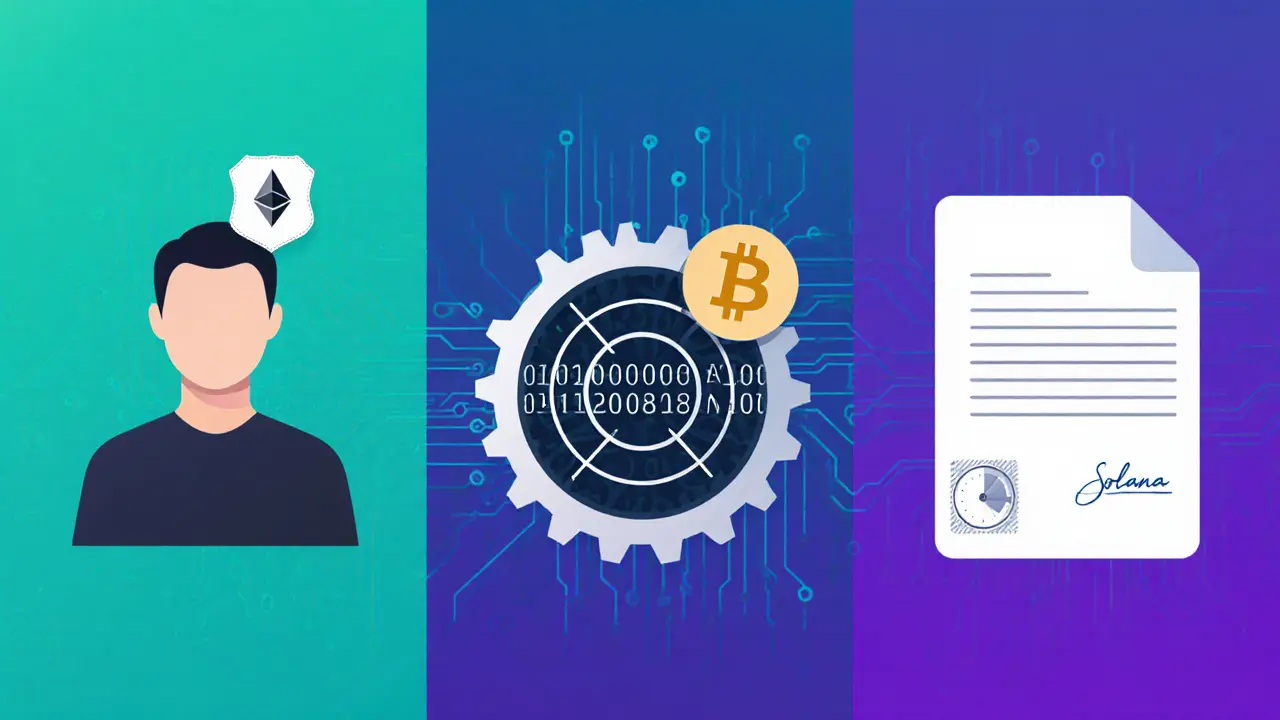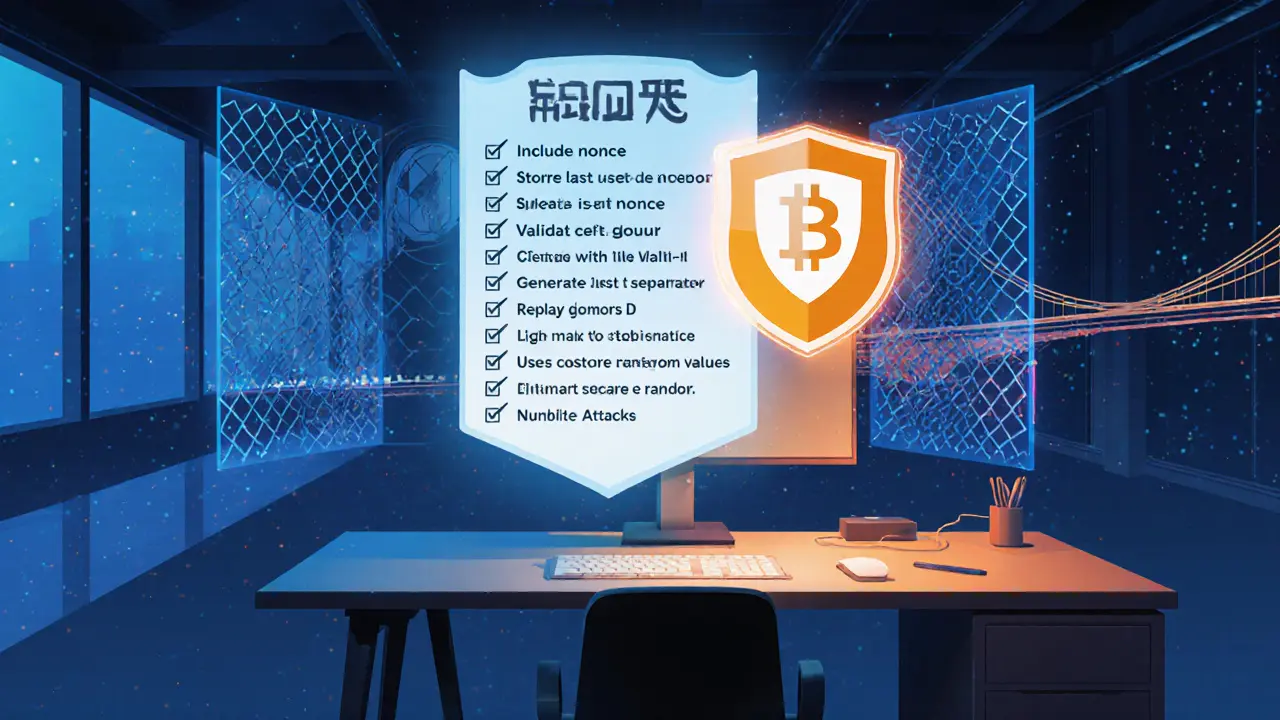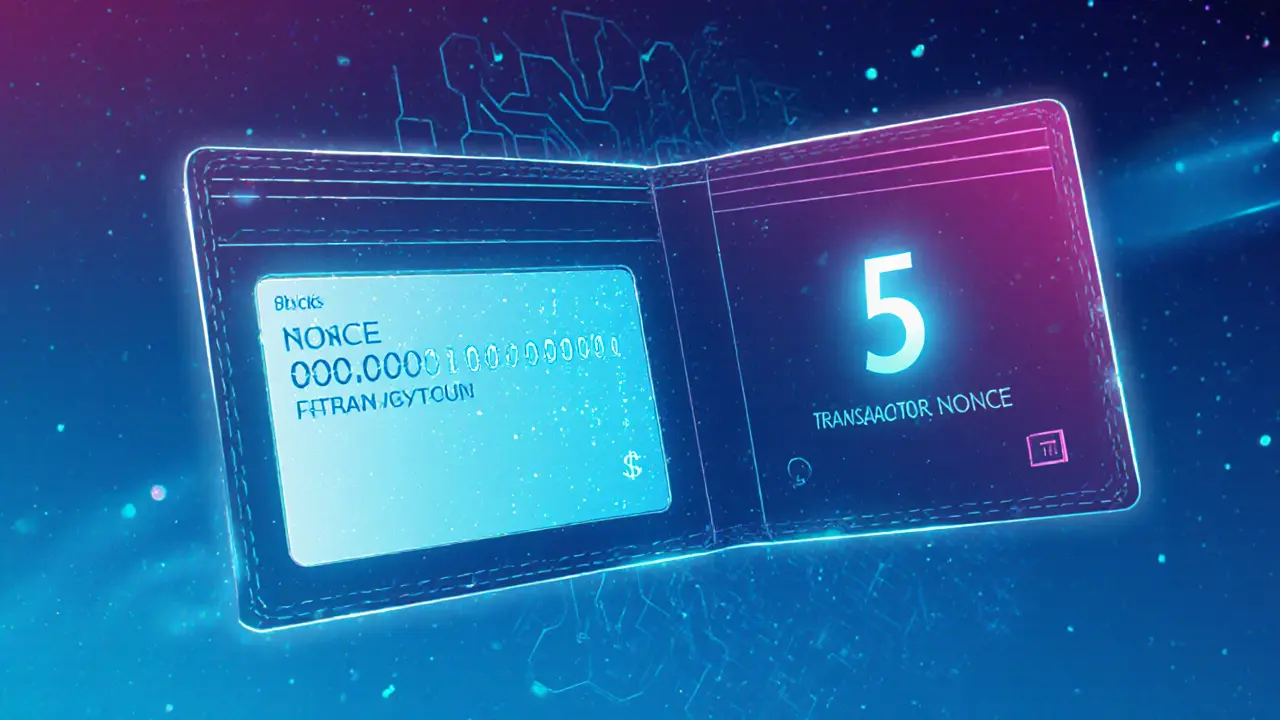Nonce Replay Protection Simulator
Validation Result
Ever sent a crypto transaction that seemed fine, only to discover it got copied and resent by a bad actor? That’s a replay attack, and the hero that stops it is the nonce replay protection mechanism built into most blockchain protocols.
What a nonce actually is
In cryptographic terms, a Nonce is a unique, arbitrary number used once to guarantee freshness of a message or transaction. The word comes from “number used once,” and its job is simple: make sure the same signed data can’t be accepted twice.
How nonces block replay attacks
When you sign a transaction, the signature covers every field-including the nonce. If an attacker tries to resend the exact same payload, the network checks the nonce against the sender’s recorded counter. Because the nonce has already been used, the transaction is rejected as a duplicate. This tiny number adds a strong temporal guard without needing extra overhead.
Different flavours of nonces in blockchain ecosystems
- Transaction nonce (Ethereum): Each address keeps a counter in the world state. Every outgoing transaction must use the next integer value. The Ethereum network records this counter, ensuring both uniqueness and proper ordering.
- Mining nonce (Bitcoin): In proof‑of‑work, miners vary a random 32‑bit number until the block hash meets the difficulty target. The Bitcoin protocol treats this as a brute‑force puzzle rather than a replay guard, but the principle-producing a one‑time value for each block-mirrors the nonce concept.
- Application nonce (Smart contracts): Contracts often store a mapping
address => uint256 lastNonce. When a signed message is processed, the contract checks that the supplied nonce is exactly one higher than the stored value, then updates it. This stops a captured signature from being replayed later. - Chain ID + nonce combo (EIP‑155): After the Ethereum‑Classic split, EIP‑155 added the chain identifier to the signed payload. Together with the transaction nonce, it ensures a transaction meant for chain 1 can’t be replayed on chain 2.
- Durable nonce (Solana): Solana introduced an
AdvanceNonceinstruction where a delegated authority signs a durable nonce account. The signed transaction can be broadcast later, even after the original blockhash expires.
Best‑practice checklist for developers
- Always include a nonce field in every signed message you accept.
- Store the highest processed nonce per signer in a reliable on‑chain mapping. Never reset it.
- Validate that the incoming nonce is exactly
lastNonce + 1(or greater, if you allow out‑of‑order processing) before executing logic. - Combine the nonce with the network’s Chain ID to avoid cross‑chain replay hazards.
- For off‑chain signatures (e.g., meta‑transactions), prepend a domain separator to the signed payload so the nonce can’t be mis‑interpreted by another contract.
- Use a cryptographically secure random source when generating non‑sequential nonces (e.g., in HTTP digest authentication) to prevent prediction.

Common pitfalls that lead to replay vulnerabilities
Even seasoned developers slip up. Here are the most frequent mistakes:
- Missing nonce check: Some contracts only verify a signature but never look at the nonce value. The result is a classic replay vector where an attacker can resubmit the same signed message indefinitely.
- Resetting nonces on upgrades: If a contract is upgraded and the nonce mapping is cleared, previously captured signatures become valid again.
- Using timestamps alone: Timestamps can be manipulated within limited windows. A timestamp without a nonce still allows repeats if the attacker stays within the same period.
- Predictable nonces: In challenge‑response protocols, generating a nonce by simple increment can enable an attacker to guess future values and forge requests.
Real‑world examples
On Ethereum, every wallet client automatically increments the transaction nonce. If you try to send two identical transactions with the same nonce, one will be mined and the other will be dropped as a duplicate.
In a 2023 DeFi exploit, a smart contract failed to store the last used nonce. Attackers captured a signed “withdraw” message and replayed it dozens of times, siphoning funds before the bug was patched.
Solana’s durable nonce accounts have been used by high‑frequency traders to lock in a blockhash for several minutes, allowing them to submit time‑sensitive orders without fear of the transaction becoming stale.
Future directions: quantum‑resistant and multi‑chain nonces
As quantum computers loom, researchers are investigating lattice‑based nonce generation that remains unpredictable even against quantum attacks. Additionally, multi‑chain bridges are beginning to embed both a transaction nonce and a cross‑chain identifier, creating a layered defense against replay across disparate ledgers.
Quick reference (TL;DR)
- Nonce = unique number used once; prevents replay.
- Ethereum uses sequential transaction nonces stored in world state.
- Bitcoin’s mining nonce is a proof‑of‑work puzzle, not a replay guard.
- Smart contracts must track per‑signer nonces in storage.
- Combine nonce with chain ID (EIP‑155) for cross‑chain safety.
- Never reset or omit nonce checks; always validate ordering.
- Future work focuses on quantum‑resistant generation and multi‑chain coordination.
Comparison of nonce types across leading platforms
| Platform | Purpose | Generation method | Storage location | Replay guard? |
|---|---|---|---|---|
| Ethereum | Transaction ordering & uniqueness | Sequential counter per address | World state (account nonce) | Yes |
| Bitcoin | Proof‑of‑work solution space | Random 32‑bit value iterated until hash < difficulty | Block header | No (different goal) |
| Solana (durable) | Long‑lived transaction signatures | Designated nonce authority signs a nonce account | On‑chain nonce account | Yes |
| HTTP Digest Auth | Challenge‑response freshness | Server‑generated random string | Transient; sent in WWW‑Authenticate header | Yes |
| Lamport signatures | One‑time signature scheme | Secret nonce per message, revealed after signing | Off‑chain secret storage | Yes (by design) |

Frequently Asked Questions
Why does Ethereum need a nonce for every transaction?
The nonce guarantees two things: each transaction from an address is unique, and transactions are processed in the order the sender intended. Without it, anyone could copy a signed transaction and replay it indefinitely.
Can a replay attack happen across different blockchains?
Yes, especially after hard forks. This is why EIP‑155 adds the chain ID to the signed payload - the same nonce on Ethereum mainnet won’t be accepted on a forked chain because the chain ID differs.
What happens if a smart contract forgets to store the last used nonce?
An attacker can resend a previously captured signature forever, effectively creating an unlimited replay window. The contract would execute the same logic each time, which often leads to fund loss.
Are random nonces better than sequential ones?
For transaction ordering (like Ethereum), sequential nonces are required to preserve intent. For challenge‑response protocols, randomness is crucial to prevent prediction. The choice depends on the threat model.
How do durable nonces on Solana differ from Ethereum’s transaction nonce?
Solana’s durable nonce is stored in a separate account and signed by a designated authority, allowing a transaction to remain valid across multiple blockhash expirations. Ethereum ties the nonce directly to the sender’s account state, so the transaction becomes stale if the blockhash changes before inclusion.


24 Responses
Understanding nonces is fundamental for secure blockchain development. In practice, always store the highest nonce per address and never reset it after upgrades. 📚 Combining the nonce with the chain ID, as described in EIP‑155, adds an extra layer of cross‑chain protection. If you embed these checks into your smart contracts, replay attacks become practically impossible. Happy coding!
Great, another endless list of nonce rules we all love to ignore.
The saga of the nonce, dear readers, reads like an epic battle between order and chaos. From the humble beginnings of a simple counter in Ethereum, it has evolved into a cornerstone of cryptographic hygiene. Every transaction, like a soldier marching to the front lines, must carry its unique insignia to be recognized. When that insignia, the nonce, is duplicated, the network cries out in dissent, rejecting the perilous duplicate. Such a scenario, alas, is a replay attack, a villainous act that threatens the sanctity of the ledger. To thwart this menace, protocols embed the nonce deep within the signed payload, binding it irrevocably to the sender. Moreover, the introduction of chain identifiers, as mandated by EIP‑155, seals the fate of cross‑chain impersonation. Imagine a rogue attempting to replay a transaction on a forked chain; the mismatched chain ID shatters their ambition. Developers, therefore, must vigilantly enforce that each inbound transaction presents a nonce exactly one greater than the stored value. Failure to do so opens a gaping portal for adversaries to siphon assets with impunity. In the realm of smart contracts, this rule manifests as a simple mapping from address to uint256. Every time a signed message is processed, the contract increments this counter, fortifying the barrier against replay. Even in non‑Ethereum ecosystems, we observe analogous mechanisms, such as Solana’s durable nonce accounts. These accounts permit the reuse of a signed transaction across multiple blockhash expirations, yet they still enforce uniqueness. The overarching principle remains unchanged: a one‑time number safeguards the temporal freshness of every operation. Thus, the nonce stands not merely as a technical detail, but as a sentinel guarding the integrity of decentralized finance.
Listen, the whole nonce thing is not rocket science – you just increment a number. If you reset it during an upgrade you just hand the keys to the attacker.
It’s easy to overlook nonce handling when you’re focused on business logic, but forgetting it can cost dearly. Make sure your contract stores the last used nonce persistently. A simple require check can prevent a whole class of replay exploits. Keep the community safe!
Your description simplifies the concept, yet omits the importance of atomicity in nonce updates. 👀
They'll exploit any reset, and the whole network suffers – that's why you must guard every nonce like a secret.
Oh sure, store the nonce forever – because storage is free, right? In reality, you need to balance gas costs with security, but never sacrifice the latter. Keep it simple, keep it safe.
Nice summary, though remember to also validate that the nonce isn’t stale. 🙂
Nonces might sound scary, but they’re just numbers that keep your money safe. Every wallet you use already handles them for you. Keep learning and you’ll master blockchain security!
The nonce functions as a temporal nonce‑entropy vector, ensuring transaction freshness within the state machine. By coupling this with the chain identifier, we instantiate a two‑factor replay defence. In distributed ledger theory, this duality mitigates both intra‑chain and inter‑chain duplication attacks. Practitioners should therefore embed deterministic increment logic alongside robust signature verification. Such architectural rigor preserves consensus integrity.
From an engineering standpoint, always persist the highest nonce in contract storage before any external call. Validate the incoming nonce against this persisted value atomically. Remember to bump the nonce even if the transaction reverts to avoid gaps. This pattern eliminates race conditions that could be exploited.
You think a nonce is just a number? It's the silent guardian of your digital assets, the unsung hero that stops copy‑pasta attacks. Without it, every transaction is a free replay ticket. Respect the nonce, respect the chain.
Great post, really helped me understand!
Everyone talks about nonces like they're harmless, but have you ever considered who decides the starting value? Some say the founders embed backdoors in the initial state. If the nonce sequence is ever compromised, all downstream contracts are vulnerable. Stay vigilant, question the defaults, and audit the genesis block.
Seriously, if you ignore nonce checks, you're basically leaving a window for thieves 🚨. A single replay can drain wallets faster than you can say 'gas fee'. Harden your contracts now, or regret it later. #SecurityFirst
India's blockchain tech will outshine these weak nonce tricks any day.
The concept of a nonce mirrors the philosophical idea of a moment that never repeats. Each transaction captures a unique point in time, safeguarding its singularity. Embracing this principle can guide us toward more resilient systems. Let’s build with that awareness.
One must first acknowledge the hierarchical nature of blockchain security, wherein the nonce occupies a pivotal stratum; it is not merely an auxiliary datum, but a cornerstone of replay mitigation, especially when coupled with chain identifiers, as prescribed by EIP‑155; furthermore, the deterministic progression of nonces enforces transaction ordering, preventing malicious re‑ordering attacks, and consequently upholds network consensus; a developer neglecting this mechanism demonstrates a flagrant disregard for protocol integrity; thus, rigorous implementation and continuous audit of nonce handling are non‑negotiable; only then can we aspire to a truly robust decentralized ecosystem.
Oh, look who's preaching about nonces-maybe next they'll tell us how to tie our shoes! But seriously, the more noise you add, the less we hear the actual security concerns.
Did anyone notice how the nonce pattern repeats across different chains? It's a neat design principle that could be standardized. 😊
Jargon aside, nonces are just counters that stop double‑spends. Keep them simple.
Simple? That’s a naive romanticism-real security demands layered defenses beyond a mere counter!
Wow, yet another endless rant about nonces, absolutely riveting, utterly groundbreaking, and… meh.